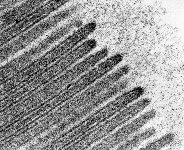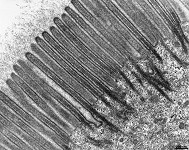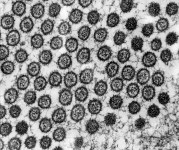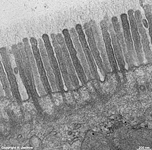Overview glycocalix (Glycocalyx):
Pages with explanations are linked to the
text below the images if available! (Labelling is in German)
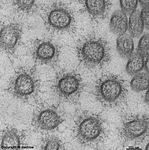 |
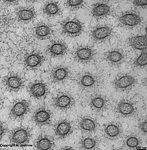 |
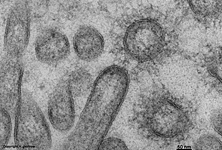 |
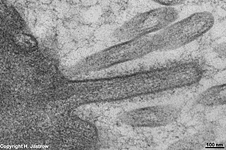 |
microvilli + glycocalyx
human pharyngeal tonsil |
overview thereof |
glycocalyx covered microvilli
human pharyngeal tonsil |
glycocalyx covered microvilli of
the human pharyngeal tonsil |
The cell surface coat, i.e. the glycocalyx (Terminologia
histologica:
Glycocalyx) summarizes all sugar molecules which are
bound to cell-surface proteins or -phopholipids on the outer cell membrane.
The name derives from the Greek words glykos (sugar) and kalyx (coat)
but not from Latin calix (goblet). Common staining
and contrastation in electron microscopy using osmiumtetroxide shows
the glycocalyx as mesh- or network of moderate electron-density sprouting
off the outer lamella of the cell
membrane into surrounding space. Application or ruthenium red results
in a more intense staining. Glycolipids reach from the outer lamella of
the cell membrane towards
the extracellular space and bind different sugars of intermediate size
(oligosaccharids) with varying chain lengths as well as sugar derived
acids (sialic acids) in this region. Glucose, Galactose, Fucose,
N-Acetyl-Glukosamin, N-Acetyl-Galaktosamin and N-Acetyl-Neuraminsäure
are the most important sugar components of the glycocalyx. Further
proteins which are integrated into the cell
membrane (glycoproteins, proteoglycans) extend considerably towards
the extracellular space where they attach shorter oligosaccharid-
or longer glycan chains. The presence of multiple anionic components
like sulfated glycosaminoglycans or sialic acids bound to such chains is
the reason for the negative charge of the cell surface.
Further components of the glycocalyx are the long extracellular portions
of mucins, especially the tans membrane protein mucin-1 and large sugar
proteins of mucus which are also secreted by glandular
cells like the goblet cells of the colon.
The composition of the glycocalyx is cell specific and important
in the formation of tissues. Similarly differentiated cells identify each
other using this surface sugar matrix during ontogenesis to aggregate in
tissue formation.
The glycocalyx is regenerated by synthesis of glycoproteins and
glycolipids. The glycoproteins are synthesised in the rough
endoplasmic reticulum and are then transported into the Golgi-apparatus
to receive their sugar components and to get integarted into the membrane
of Golgi-vesicles. Formation of glycolipids is also managed by the Golgi-apparatus.
The Golgi-vesicles are then transported to the cell
membrane to fuse with it.
--> microvilli, cell
membrane, rough endoplasmic reticulum, Golgi-apparatus,
Epithelia
--> Electron microscopic atlas Overview
--> Homepage of the workshop
Two images were kindly provided by Prof. H. Wartenberg;
other images, page & copyright H. Jastrow.





